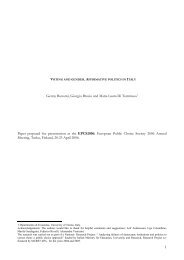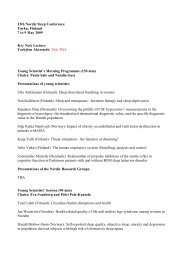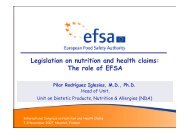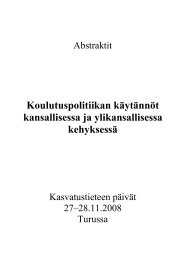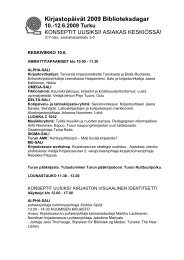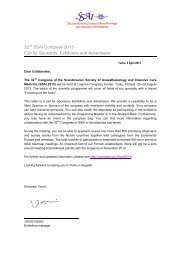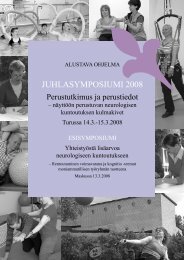Abstract information: Writing Guide to Authors
Abstract information: Writing Guide to Authors
Abstract information: Writing Guide to Authors
You also want an ePaper? Increase the reach of your titles
YUMPU automatically turns print PDFs into web optimized ePapers that Google loves.
SSAI 2013 Congress 26-29 August Updated 24/01/2013 11:59:00 http://congress.utu.fi/ssai2013/<br />
<strong>Abstract</strong> <strong>information</strong>: <strong>Writing</strong> <strong>Guide</strong> <strong>to</strong> <strong>Authors</strong><br />
I. <strong>Writing</strong> <strong>Guide</strong> <strong>to</strong> <strong>Authors</strong><br />
It is the policy of the 32nd Congress of the SSAI <strong>to</strong> ensure balance, independence, objectivity, and<br />
scientific rigor in the Congress. It is expected that your presentation will be unbiased, based on the<br />
best available evidence and all elements of the presentation will be free from the control of<br />
commercial interests. Therefore all authors presenting abstracts/posters are expected <strong>to</strong> disclose<br />
any real or apparent conflict(s) of interest that may have a direct bearing on the subject<br />
matter of the presentation. This includes, but is not limited <strong>to</strong>, fac<strong>to</strong>rs such as financial<br />
relationships, advisory positions, and receipt of payments, expenses, grants, or departmental<br />
support, and membership of other organisations. The intent of the policy is not <strong>to</strong> prevent<br />
speakers/chairpersons with a potential conflict of interest from their contribution in the congress but<br />
<strong>to</strong> identify openly eventual conflicts of interest so that the participants of the Congress may form<br />
their own judgements about a possible bias of the presentation. You will have <strong>to</strong> give details in the<br />
abstract submission system. The eventual conflicts of interest have <strong>to</strong> be shown also in the<br />
presentation of the abstract as a poster or oral presentation.<br />
Studies involving animal or human subjects must be conducted according <strong>to</strong> the European<br />
regulation authorities for ethics in human or animal research. A statement is required<br />
indicating that an independent Ethics Committee (IEC), Ethical Review Board (ERB) or Ethics<br />
Committee has approved prospective clinical studies and/or that an Institutional Review Board<br />
(IRB) for animal experimentation approved the study. If such an approval was not obtained, the<br />
abstract will be rejected.<br />
1. Typing and formatting<br />
1. The abstract must be written on the template that is provided by the abstract handling system.<br />
The template will be send <strong>to</strong> you as an email attachment when you register <strong>to</strong> the system for<br />
the first time.<br />
2. The abstract should be written in English. Use British spelling, e.g. anaesthesia, oesophagus,<br />
crystalloid. However, you can easily eliminate many typing errors and misspelling by using the<br />
spell-check feature of your word processing software. The layout of the abstract should be the<br />
following:<br />
3. Use Arial font with a size of 11 point.<br />
4. Title Box must only include the Title. Total number of characters allowed including spacing is<br />
150. Use BOLD CAPITAL letters.<br />
5. Write the body of the abstract in<strong>to</strong> the Text Box, starting a new line for each subheading. The<br />
subheadings should be typed in Bold case. Following subheadings should be used (as<br />
applies):<br />
<br />
Introduction, Methods, Results, Discussion, (References).<br />
6. The <strong>to</strong>tal number of characters allowed including spacing and eventual table text is 2800.<br />
7. Use the SI-system for all units of measurement (e.g. ml, kg, kPa) with the exception of mmHg<br />
for blood pressures. With two items or more, negative exponents should be used<br />
(e.g. ml • min -1 ). The number of abbreviations should be minimised, and they must be defined<br />
the first time they are used.
SSAI 2013 Congress 26-29 August Updated 24/01/2013 11:59:00 http://congress.utu.fi/ssai2013/<br />
8. One table within the borders of the abstract is allowed and encouraged where the results are<br />
best represented in table format. The table must be editable, preferably in Word format. Text<br />
size in the table should be no smaller than 10 point. Be sure that all text in the table is<br />
readable. No illustrations are allowed in the abstract.<br />
9. You may use no more than three relevant references, numbered ([1]) in order of appearance in<br />
the text and listed at the end of the text. If you use references, they should have the following<br />
sequence: author(s), title, journal (as abbreviated in Index Medicus), year, volume and pages.<br />
For example: Latimer RD et al. Inhaled nitric oxide in the management of pulmonary<br />
hypertension after mitral valve surgery. Br J Anaesth 1994; 72: 185-9. The text size of the<br />
reference(s) should be no smaller than 10 point and the font should be Arial (or similar).<br />
10. Key words are not needed



